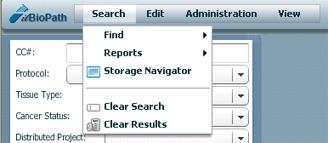- Welcome
- Use case
- Getting Started
-
Searching Records
- Performing a Basic Search
- Performing an Advanced Search
- Performing a List Search
- Performing a Keyword Search of UUMC Pathology Reports for all Patients in the Database
- Performing a Keyword Search of UUMC Pathology Reports for the Patients Associated with a Specific Set of Specimens
- Restrictions on Searches
- Reports
-
iQ Tool
- Adding Columns to a Query
- Starting the iQ Tool
- iQ Tool Window
- Current Query Data Group
- Saved Queries List
- Top Portion of the Selected
- Display or Report Columns Section
- Find/Filters Section
- Running a Preexisting Query
- Creating a Query
- Create Query Window
- Copying and Altering a Preexisting Query
- Removing Columns from a Query
- Editing Column Parameters in a Query
- Changing the Order of Columns in a Query
- Adding Filters to a Query
- Editing Filters in a Query
- Ways of Comparing Data
- Removing Filters From a Query
- Results Window
- Application Data Structure
- Application Database Fields Alphabetical List
- Application Datatree
- Field Paths List for the iQ Tool
-
Adding Specimens to the Database
- Adding a Single Specimen using the Add Specimen Wizard
- Adding a Batch of Specimens using the Add Specimen Expert Tool
- Saving a Batch of Specimens to be added as a Work in Progress
- Finishing a Work in Progress Batch
- Printing Barcodes for a Specimens in a Batch added using the Add Specimen Expert Tool
- Customizing the Add Specimen Expert Tool to Streamline Specimen Batch Entry
- Changing which Box an Add Expert Template Points for Adding Storage
- Importing FFPE Samples from UUMC
- Entering and Editing Specimen Records
- Transformations
- Specimen Disbursement and Registration
- Reports and Records
- Adding a Pathology Report to a Specimen Record
- Performing a DEXT Import of a Pathology Import
- Checking on the status of your DEXT Import Request
- Adding a Medical Record to a Specimen Record
- Editing Patient or Collection Records
- Editing Collection Records
- Editing Patient Records
- Diagnoses
- Adding a Diagnosis to a Patient Record
- Linking an Existing Diagnosis to one or more Collections
- Linking a Collection to a Diagnosis
- Recording a Consent for a Patient
- Reviewing a Patient's Consents
- Uploading a Patient's Consent Form
- Managing Patient Consents
- External (to itBioPath) Data Sources
- Managing Dictionaries
-
Storage
- Editing Aliquots
- Connecting a Barcode Label Printer to itBioPath
- Removing a Barcode Label Printer from itBioPath
- Freezer Management
- Viewing the Contents of a Box in a Freezer
- Accessing the Specimen Record for the Specimen associated with an Aliquot
- Editing Box Details
- Adding a New Box to a Freezer from the Add Aliquot Window
- Managing Protocols, Projects, and Related User Permissions
- Window, Tab, and Field Descriptions
- Miscellaneous
The user interface for itBioPath is designed to be flexible and user-friendly. There are some powerful features of the interface that the user may not be aware of without some instruction or clarification. Everything in the application can be accessed and every task in the application can be performed without the use of a mouse. Especially when performing data entry, you may find it more convenient and faster to use the available keyboard short cuts to operate the interface. To help you to learn what these are, we have provided a topic that includes a complete list of itBioPath's Keyboard Shortcuts.

There are three main areas to the itBioPath interface. Along the top are a series of menus that are used to initiate most of the tasks to be performed in itBioPath. The function of these menu options will be discussed throughout this help documentation in topics describing each type of task.
The second area of the itBioPath interface is the search pane. This pane is used to provide access to specific specimen records by allowing the user to search for specimens in a variety of ways. Read The Search Pane for more information about this part of the interface, including a description of different ways to control the size and appearance of this pane. The final area of the interface is empty when the application first begins. This is the itBioPath desktop pane, where most of the windows representing specimen, collection, patient and other records will appear. There are also three additional buttons in the upper right corner of the application. The Profile button displays the current user's user profile, including security permissions that user has relative to the application in general, to various collection protocols and to specific projects that a specimen might be registered with or disbursed to. These permissions combine to control what information the user has access to for each record in the database. This is further discussed in the documentation section Granting a User Permission Relative to a Protocol or Project and Frequently Asked Questions About itBioPath. The Help button accesses this help documentation, and the Exit button logs the user out of itBioPath and closes the application window.

The interface for a number of features within the application are configurable. Users may select options to build their own interface. This is especially useful when a particular action will be performed multiple times, especially when default fields are consistently not required by the user. Instructions are provided in this documentation for performing the customization — see Customizing the Add Specimen Expert Tool to Streamline Specimen Batch Entry.




